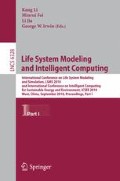Abstract
In order to shift from platform centric warfare to Network Centric Warfare (NCW) for the military simulation, a new adaptive combat agent model is designed that with some special sub-agent advisor. The sub-agent advisor can perform like a specialist to carry out the management of sensors, situational assessment, tactical decision-making, combat mission, and communication management. So we can demonstrate realistic and valid behaviors of military entities in a Computer Generated Forces (CGF) simulation. It provides an effective training environment to exhibit advanced coordination and cooperation capability of military units in NCW with high resolution simulation.
Access this chapter
Tax calculation will be finalised at checkout
Purchases are for personal use only
Preview
Unable to display preview. Download preview PDF.
References
Parunak, H., Sven, B.: Entropy and Self-Organization in Multi-Agent Systems. In: Proceedings of the International Conference on Autonomous Agents, pp. 124–130 (2001)
Jilson, E.W., Mert, E.: Modeling Conventional Land Combat in a Multi-Agent System Using Generalizations of the Different Combat Entities and Combat Operations. Master’s Thesis, Naval Postgraduate School (2001)
Yang, A., Abbass, H.A., Sarker, R.: Landscape dynamics in multi-agent simulation combat systems. In: Webb, G.I., Yu, X. (eds.) AI 2004. LNCS (LNAI), vol. 3339, pp. 39–50. Springer, Heidelberg (2004)
Functional Description of a Command Agent. Lockheed Martin Corporation, ADST-II-CDRL-023R- 96OO237A (1997)
Hencke, R.B.: An Agetn-based Approach to Analyzing Information and Coordination in Combat. Master’s Thesis, Naval Postgraduate School (1998)
David, T., Lee, L.: Testing a New C2 Model of Battlefield Information Sharing and Coordination. In: The 14th ICCRTS, Washington, DC (2009)
Author information
Authors and Affiliations
Editor information
Editors and Affiliations
Rights and permissions
Copyright information
© 2010 Springer-Verlag Berlin Heidelberg
About this paper
Cite this paper
Zhang, Y., Zhang, A., Xia, Q., Guo, F. (2010). Research on Modeling and Simulation of an Adaptive Combat Agent Infrastructure for Network Centric Warfare. In: Li, K., Fei, M., Jia, L., Irwin, G.W. (eds) Life System Modeling and Intelligent Computing. ICSEE LSMS 2010 2010. Lecture Notes in Computer Science, vol 6328. Springer, Berlin, Heidelberg. https://doi.org/10.1007/978-3-642-15621-2_24
Download citation
DOI: https://doi.org/10.1007/978-3-642-15621-2_24
Publisher Name: Springer, Berlin, Heidelberg
Print ISBN: 978-3-642-15620-5
Online ISBN: 978-3-642-15621-2
eBook Packages: Computer ScienceComputer Science (R0)

